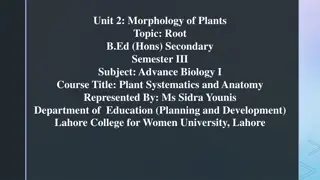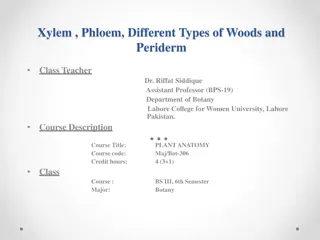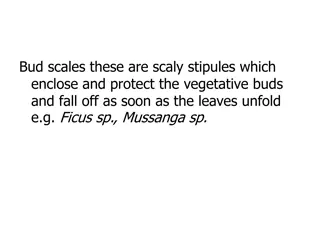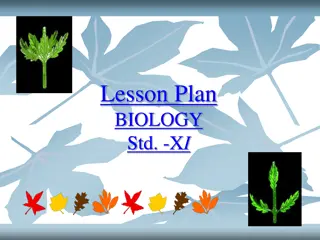Understanding the Anatomy of a Leaf in Plant Biology
The anatomy of a leaf in plant biology is essential for understanding its structure and functions in photosynthesis and transpiration. This article explores the different parts of a leaf, including the leaf base, petiole, and lamina, as well as the types of leaves and venation patterns. By delving into the intricacies of leaf anatomy, we gain insights into the vital role leaves play in the overall functioning of plants.
Download Presentation

Please find below an Image/Link to download the presentation.
The content on the website is provided AS IS for your information and personal use only. It may not be sold, licensed, or shared on other websites without obtaining consent from the author. Download presentation by click this link. If you encounter any issues during the download, it is possible that the publisher has removed the file from their server.
E N D
Presentation Transcript
LEAF Types, Origin, Bundle Sheaths and Extensions Class Teacher Dr. Riffat Siddique Assistant Professor (BPS-19) Department of Botany Lahore College for Women University, Lahore Pakistan. Course Description Course Title: Course code: Credit hours: PLANTANATOMY Maj/Bot-306 4 (3+1) Class Course : Major: BS III, 6th Semester Botany
Table of contents Structure of a Leaf Parts of a Leaf Types of Leaf Origin of Leaf Bundle Sheath Bundle Sheath Extentions
Structure of a Leaf Among the different parts of a plant, the leaf is the most essential. Primarily, leaves have two functions: photosynthesis and transpiration. Leaves are thin, flat organs responsible for photosynthesis It develops laterally at the node, It is an important part of the shoot system and originates from shoot apical meristems. Parts of a Leaf Generally, leaf base, petiole, and lamina, together form the main parts of a leaf. Leaf Base: This is the part where a leaf attaches to the stem. Leaf base has two small leaf-like structure called stipules. In plants like paddy, wheat, and other monocotyledons, this leaf base is wide and masks the stem. Petiole: Petiole is the long, thin, stalk that links the leaf blade to the stem. Lamina: Also known as leaf blade. It is the green, flat surface of the leaves. It consists of a small branched vein and veinlets. The vein that runs along the middle of the lamina is called midrib. Midrib divides the surface of the lamina into two. These veins and veinlets give rigidity to the leaf blade and help in the transportation of water and other substances. Source: https://byjus.com/biology/leaves-morphology-types-modification/
Parts of leaf Source:https://www.google.com/search?q=parts+of+leaf&safe=active&sxsrf=ALeKk01dx3q41Y- ffq6FJKWwNt7pIa0lBg:1588613317986&tbm=isch&source=iu&ictx=1&fir=iuQe5-BiwPS1lM%253A%252CCNm0v- xO3qSPjM%252C_&vet=1&usg=AI4_-kQbpMhDuoi-N52zQhHnd48A- s7zHQ&sa=X&ved=2ahUKEwjy14Pk3ZrpAhU88uAKHTL3AuMQ9QEwA3oECAUQNQ
Venation Venation is defined as the arrangement of veins and the veinlets in the leaves. Different plants show different types of venation. Generally, there are two types of venation Reticulate venation: In a reticulate venation, the veinlets are randomly arranged and form a complex network of veinlets. Ex: Dicotyledonous plants like a rose plant. Parallel venation: In a parallel venation, the veinlets run parallel to each other. Ex: In monocotyledons like paddy Parallel venation Reticulate venation
Types of Leaves There are two broad categories of leaves simple and compound, which are further classified into different groups based on their shape, size, their arrangements on the stem, leaves of flowering and non-flowering plants, and various other physical attributes. Simple Leaf When a single lamina is connected to the main stem by a petiole, the leaf is said to be simple. A simple leaf may be incised to any depth but not down to the midrib or petiole. Eg., Guava leaves. Compound Leaf A compound leaf is a leaf made up of two or more leaflets. In a compound leaf, the midrib of the leaf is branched into different leaflets and is connected by a single petiole. For eg., Pea, palm leaves.
Types of compound leaves The compound leaves are further sub-divided into the following types of leaves: 1. Types of Palmately Compound Leaf In a palmately compound leaf, the leaflets are attached at the tip of the petiole. Eg., Silk cotton. these are further of various types as, Unifoliate: These type of leaves have only one leaflet. Eg., Citrus Bifoliate: These leaves have two leaflets. Eg., Balanites Trifoliate: These leaves have three leaflets emerging from the same point. Eg., Oxalis Quadrifoliate: These leaves have four leaflets arising from the same point. Eg., Marsilea Multifoliate: This type of leaf has many leaflets arising at a common pint. Eg., Bombax Source:https://byjus.com/biology/leaves-morphology-types-modification/#types
Types of Compound Leaf 2. Types of Pinnately Compound Leaf In a pinnately compound leaf, the midrib of the leaf is divided into numerous leaflets and all connected by a common axis. Eg., Neem. These can be further differentiated into: Pinnate: A compound leaf that has an axis on each side of the midrib is known as a pinnate leaf. Unipinnate: The leaf with leaflets on each side of the axis. Eg., cassia Bipinnate: Here, a secondary axis bearing the leaflet is produced by the central axis. Eg., Acacia Tripinnate: Here, a tertiary axis bearing leaflets emerges from the secondary axis. Eg., Moringa Decompound: Leaf with more than three pinnate. Eg., old leaves of coriander Parapinnate: A leaf without a terminal leaflet, or with even number of leaflets, Eg., Cassia Imparipinnate: Leaf with an odd terminal leaflet. Eg., Pea Source:https://www.kullabs.com/classes/subjects/units/lessons/notes/note-detail/1588
Functions of Leaves The leaves perform the following functions: Photosynthesis Transpiration Guttation Removal of excess water from the xylem at the edges of the leaves when the stomata are closed is known as guttation. Storage Leaves are a site of photosynthesis. Therefore, they store water and nutrients. The succulent and thick leaves particularly adapt to water storage. Defence Some leaves are modified into spines to protect them from being damaged or eaten by animals. For eg., Opuntia.
Origin of Leaf It develops from leaf primordium from promeristem of (shoot apical meristem) SAM i. Initiation: Periclinal divisions on flanks of promeristems below the apex. It produces a bulge called leaf buttress which grow laterally. Leaf primordium grows in length by activity of apical meristem present at tip. Further growth occurs by activity of apical, intercalary, adaxial & plate meristem ii. Development of leaf axis Apical meristem forms bladeless tapering cone shaped leaf-axis. Activity of apical meristem ceases & further development takes place by intercalary meristem. In monocots intercalary growth is more pronounced due to presence intercalary meristem. Source:https://www.slideshare.net/JasmineBrar4/leaf-structure-adaptations-development
Origin of Leaf iii. Growth of Lamina by Marginal Meristem The cells of margins of leaf axis becomes more active & forms leaf blade with mid-rib (marginal meristem). The marginal meristem of the leaf blade show little activity at base & form petiole. Adaxial meristem divides periclinally & makes leaf thick. Final shape & size of leaf takes place by activity of Plate meristem (meristem containing parallel layers of cells dividing anticlinally only) Source:https://www.slideshare.net/JasmineBrar4/leaf-structure-adaptations-development
Source:https://www.slideshare.net/JasmineBrar4/leaf-structure-Source:https://www.slideshare.net/JasmineBrar4/leaf-structure- adaptations-development
Differentiation of Mesophyll Tissue iv. Differentiation of Mesophyll Palisade parenchyma is formed by anticlinal divisions Spongy parenchyma is formed by anticlinal divisions but less frequent than palisade cells. The adjacent epidermal cells stop dividing & enlarge in the plane parallel to the surface of the leaf. v. Vascular Tissue Vascular tissue develop by activity of procambium that develops from plate meristem. Phloem develops earlier than xylem. The midrib & lateral veins are formed during intercalary growth. Source:https://www.slideshare.net/JasmineBrar4/leaf-structure-adaptations-development
Bundle Sheath The larger leaf veins are surrounded by parenchymatous with poorly developed chloroplast while the smaller veins are enclosed in one or more layers of compactly arranged cells forming the Bundle Sheath. The bundle sheath in a leaf is a layer of compactly arranged parenchyma surrounding the vascular bundles. Bundle sheath may be parenchymatous or sclerenchymatous.
Bundle sheaths The bundle sheaths regulate the movement of substances between the vascular tissue and the parenchyma and, in leaves, protect the vascular tissue from exposure to air. Bundle sheath cells constitute 15% of chloroplast-containing cells Bundle sheath conduct fluxes of compounds both into the leaf, particularly during leaf development, and out of the leaf, during export of photosynthates and during senescence. The bundle sheath also conducts the flow of water from the xylem to the mesophyll cells and then to the intercellular spaces. The bundle sheath cells are the only cells outside the vasculature itself (xylem, phloem, and some of their associated parenchyma cells) through which these substances must pass. Source: https://academic.oup.com/jxb/article/59/7/1663/639746
Bundle sheaths Source: https://www.google.com/search?q =bundle+sheath&tbm=isch&ved=2 ahUKEwi5hcWmj5zpAhVCHBoKHb2 JDGQQ2- cCegQIABAA&oq=bundle&gs_lcp=C gNpbWcQARgBMgQIIxAnMgQIABB DMgQIABBDMgQIABBDMgIIADICC AAyAggAMgIIADICCAAyAggAOgUIA BCDAVCqLljLPWD9SmgAcAB4AIAB_ AGIAb8LkgEDMi02mAEAoAEBqgEL Z3dzLXdpei1pbWc&sclient=img&ei =6gqxXrnoIMK4aL2TsqAG&bih=657 &biw=1366&safe=active&hl=en#im grc=VG_hlbWfeNV5sM
Roles of the bundle sheath cells in leaves of C3plants In C3 plants which are normal plants, perform light reaction and dark/ calvin cycle of photosynthesis in mesophyll cells, as bundle sheath cells don t have chloroplast. They conduct fluxes of compounds both into the leaf, particularly during leaf development, and out of the leaf, during export of photosynthates and during senescence. Its metabolic roles in photosynthesis, carbohydrate synthesis and storage, the import and export of nitrogen and sulphur, and the metabolism of reactive oxygen species. Sources:https://www.ncbi.nlm.nih.gov/pubmed/18353763 https://www.google.com/search?q=what+are+bundle+sheath+in+plants&safe=active&sxsrf=ALeK k01DWerSBAd4PPVZTyWRhmI0y6JQkw:1588658708768&tbm=isch&source=iu&ictx=1&fir=O yNpLAulWncC3M%253A%252CVjd6aZ7sa8HYcM%252C_&vet=1&usg=AI4_- kSknOiGU9885koKfv0z9VAzbW4ADA&sa=X&ved=2ahUKEwjvhoXwhpzpAhUC3BoKHWqu A1AQ9QEwAHoECAoQAw#imgrc=ECsCKH7xuJjVaM
Roles of the bundle sheath cells in leaves of in C4 plants In C4plants, the bundle sheath cells have been recruited to a very specific role in photosynthetic CO2fixation, in which they form a specialized compartment in which CO2can be concentrated around Rubisco, thus suppressing photorespiration but this is in addition to other possible function. In C4plants (see C4 pathway) the bundle sheath cells contain chloroplasts and are the site of the Calvin cycle. The initial fixation of carbon dioxide to form malic acid takes place in the palisade mesophyll cells, which in C4plants form a circle around the bundle sheath. This arrangement, known as Kranz anatomy or structure (after the German Kranz, wreath), ensures that the palisade cells are in close contact with the bundle sheath cells so that the malic acid can easily pass to the bundle sheath. It also means that the products of photosynthesis can be quickly transferred from the bundle sheath to the adjacent phloem tissue for transport to other parts of the plant. Source: https://www.encyclopedia.com/science/dictionaries-thesauruses-pictures-and-press- releases/bundle-sheath-cells
C3and C4plants Source:https://www.google.c om/search?q=what+are+bun dle+sheath+in+plants&safe=a ctive&sxsrf=ALeKk01DWerSB Ad4PPVZTyWRhmI0y6JQkw:1 588658708768&tbm=isch&so urce=iu&ictx=1&fir=OyNpLAul WncC3M%253A%252CVjd6aZ 7sa8HYcM%252C_&vet=1&us g=AI4_- kSknOiGU9885koKfv0z9VAzb W4ADA&sa=X&ved=2ahUKEw jvhoXwhpzpAhUC3BoKHWqu A1AQ9QEwAHoECAoQAw#im grc=XwJUqeuxK57KhM
Kranz Anatomy Source: https://www.google.com/s earch?q=kranz+anatomy&t bm=isch&ved=2ahUKEwi02 4j3hpzpAhUNaBoKHe5UCf gQ2- cCegQIABAA&oq=kran&gs_ lcp=CgNpbWcQARgAMgQI ABBDMgIIADICCAAyAggAM gIIADICCAAyAggAMgIIADIC CAAyAggAOgUIABCDAVDC uS5Y3MAuYInQLmgAcAB4 AIABtAKIAa8IkgEFMi0zLjGY AQCgAQGqAQtnd3Mtd2l6L WltZw&sclient=img&ei=Iw KxXvS9Ho3Qae6ppcAP&saf e=active#imgrc=iCTPiER35 efnPM
Bundle sheath extension A strip of ground tissue between vascular bundles and epidermis in leaf - can be hypodermal and consist of parenchyma, collenchyma or sclerenchyma. Heterobaric leaves In many dicotyledons, cells similar to bundle sheath extend towards the epidermis and are sometimes collenchymically thickened. Leaves of sunflower have such bundle sheath extensions Such leaves are referred to as Heterobaric. Homobaric leaves: In contrast, leaves largely lacking bundle sheath extensions are termed homobaric
Bundle sheath extension Source:https://www.google.com/se arch?q=bundle+sheath+extension&t bm=isch&ved=2ahUKEwifmIrkiZzpA hUFpBoKHc84A2AQ2- cCegQIABAA&oq=Bundle+sheath+ex te&gs_lcp=CgNpbWcQARgAMgIIADI ECAAQGDIECAAQGDIECAAQGDoECA AQQzoFCAAQgwFQ9bUZWJjfGWDR 7xloAHAAeACAAb4CiAGoIpIBBjItMT cuMZgBAKABAaoBC2d3cy13aXotaW 1n&sclient=img&ei=IAWxXp- IPIXIas_xjIAG&safe=active#imgrc=ZI aVc0b7YfvX9M
Function of Bundle Sheath Extensions Leaves exhibiting bundle sheath extensions predominate in deciduous plants, whereas those without are predominantly evergreen broadleaved foliage of warmer climates has suggested that bundle sheath extensions may be involved in conduction, particularly as there is an inverse correlation with vein frequency and distribution. Bundle sheath extensions appear to be an adaptation to saving water and to protecting the mesophyll against water stress. Homobaric leaves found in hotter climates may have evolved to increase water use efficiencies, by allowing lateral CO2movement. Bundle sheath extensions in Heterobaric leaves are also likely to reduce the spread of disease, because these leaves tend to be thinner. Bundle sheath extensions may also behave as windows, increasing light penetration into the internal layers of the mesophyll, thus compensating for the reduction of the photosynthetic capacity per unit leaf area caused by the non-photosynthetic extensions. Source:https://onlinelibrary.wiley.com/doi/full/10.1046/j.1365-3040.2000.00558.x























